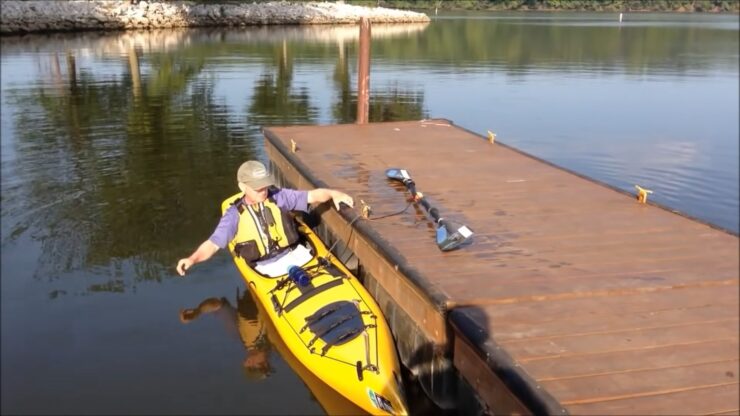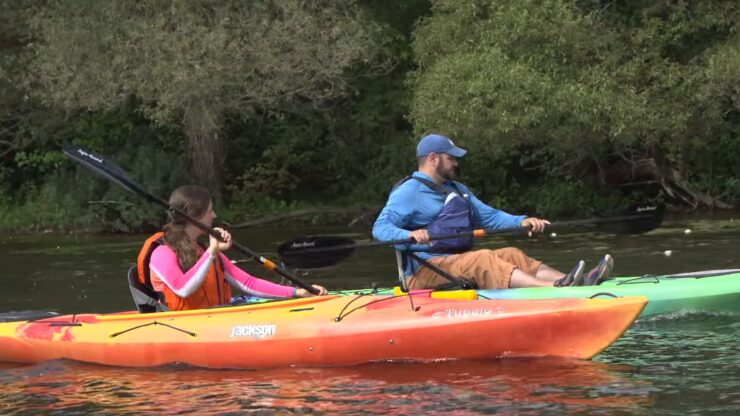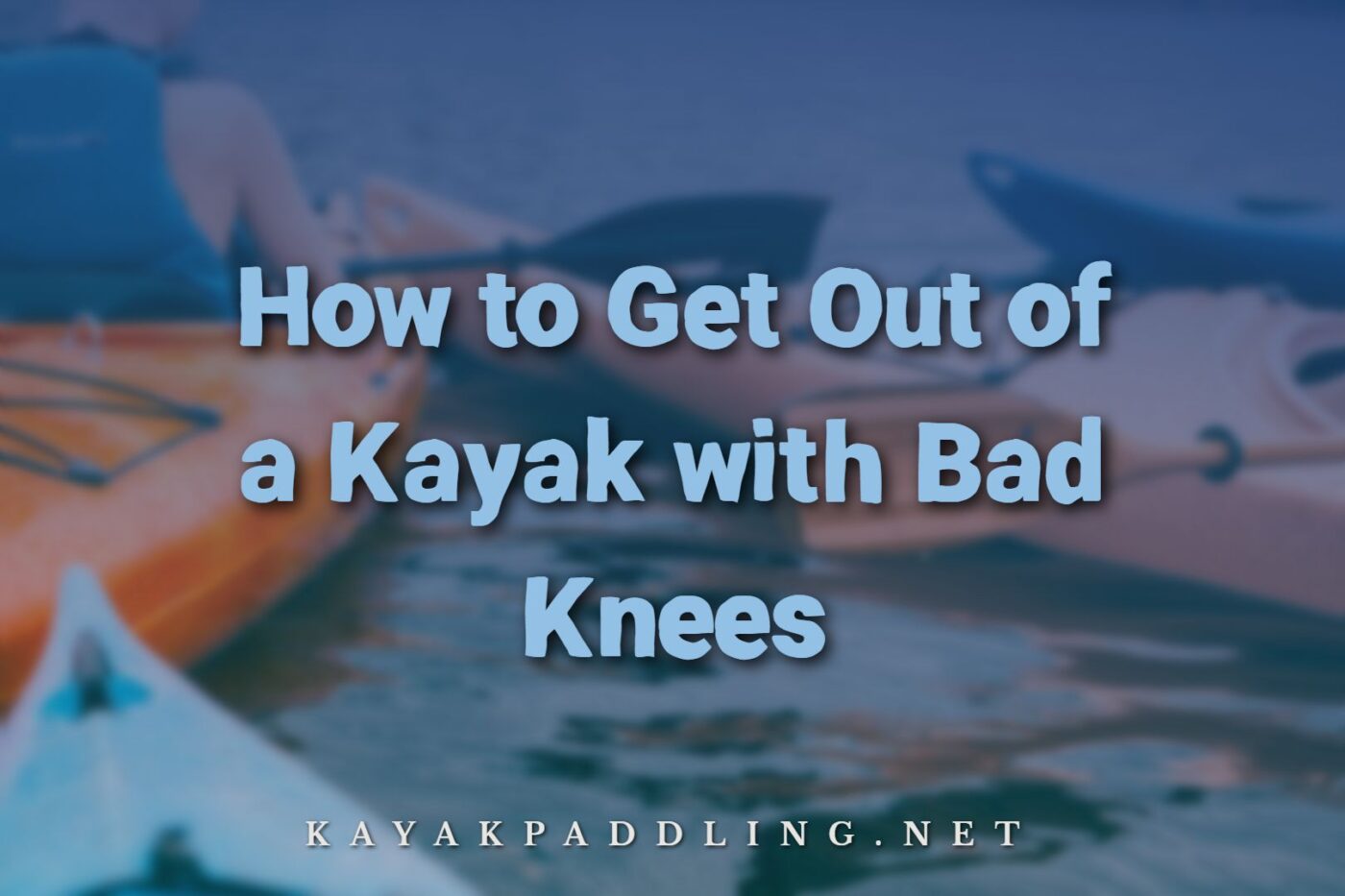Fractures or less flexibility during movements or having painful knees will not make your kayaking more enjoyable. Stiff or sensitive knees are terrible news for kayakers because preferring to sit inside the narrow cockpit could impart great stress over the already disturbed condition of your knees.
If stress is continuously applied, it may lead to the knees’ serious problems, including septic arthritis, a severe stiffness of knee joints that happens due to constant facing knee pain without consulting a doctor.
It is not necessary to always set an adventurous ride on kayaks when you have troubled knees. You may also choose kayaking for a smooth drive on water. In this way, it becomes easy to resolve “how to get out of the kayaks with bad knees.”
Pond kayaking is the best option in circumstances that offer less paddling effort and opposition from water currents. Hence, one can have a smooth and sound experience of driving over water without extending the knee joints, which causes trauma. However, many kayakers facing extreme resistance to attending a kayak with bad knees can follow the below-described rules.
These rules can help you out while sitting in and getting out of the kayaks. The guide resolves most of the concerns when you are about to set a kayak trip with bad knees or when you have begun the ride and have to face difficulties.
Table of Contents
ToggleSimple Rules to Exit a Kayak with Distressed Knees
Twelve manageable measures can make you off a kayak without exerting tension on your knee hinges. You only have to exercise and work out a couple of moments before leaving into the river. Check them out!
1. Pre-Kayaking Steps
These steps include all the necessary measures to negotiate before leaving for kayaking with bad knees. It may help you take up precautions and consider the right equipment required for a reliable journey.
-
Choose Sit-on-Top or SOT Kayak
Unlike Sit-in-side-kayaks, where the kayaker sits inside the cockpit, and this sitting covers the lower body, the sit-on-kayaks are relievable. With bad knees, it’s highly recommended always to choose a SOT kayak. Its body allows you to sit by straightening the legs while holding you back firmly. You can freely move your joints over the knee, and hence this kayak supports your comfort position. Moreover, it is more manageable for getting in or out of it.
-
Get a Doctor’s Advice
If you can only feel the bad joints’ intensity over your knees, consult your doctor to understand how damaged your knees are. The doctor could prescribe helpful advice to adopt before or during kayaking to make you aware of all the dos and don’ts when opting for a kayak ride.
Every kayaker with even a minor knee problem must take the doctor’s advice. Before it gets too late and instead of becoming a relief, it can cause critical harm to your knee bends.
-
Do Stretching Exercises
Long-term distance from any sport or any outdoor activity, including kayaking, can cause muscle stiffness and crux cramping’s. If you think of having a water trip up to some meters, a little exercise to stretch your muscles will prove helpful.
Stretching exercise maintains the excellent performance of muscles/joints and prevents muscles from getting hard again. So, consider it as your warm-up exercise, and it’s good to go now!
-
Select Compensable Accessories
Never compromise on the best quality kayaking equipment. Whether it’s the kayak, its associated accessories, or your knee-protected pads. Select the most compensable one. Saving money on these essentials will support you from all directions, and it’s going to be a productive investment.
The paddles with gloves at one end, body cushion pads, and overall the thermoformed kayak structure provides a protected suitcase for your water ride, particularly when you have bad knees.
-
Get Coaching or Training
An experienced kayaker could train you how to handle kayaking during normal conditions and with bad knees. If you are a beginner, try to comprehend all the features and points of driving a kayak more safely. The journey would become more challenging if you don’t know how to manage kayaks’ speed with painful knees. The coaching in this scenario will let you get some tricks, and it will be easy for you to understand the nature of kayaking completely.
2. During Kayaking Steps

Once you have acknowledged all the afore-mentioned steps to acquire before leaving for kayaking, it’s time to look over the components which control during-ride complexities to bad knees. These components include;
-
Prefer Low Effort Drive
High-speed kayaking or kayak competitions are undoubtedly thrillful activities and a fantastic sport type that would be mentioned on every adventure lover’s list of hobbies. But if you get a bad or painful knee that doesn’t allow you to be a part of such an adventure, then go for some peaceful kayaking trips or hangouts in the middle of the water.
It will be your right choice because bad knees are unpredictable trouble points. So, it’s better to be reliable for yourself by keeping you away from severe accidents.
-
Never Skid or Carve the Kayak
It is the game of your paddles to manage a fast or average speed of kayaks. Turning the paddles fast and in a state where you’re not moving with kayak speed could create skidding and carving of the ride. In your kayak’s carving position, the sharp edges make two height peaks, one towards the water surface and another border on some height. Such stents are assuredly a risky matter for bad knees kayakers.
Thus, it’s better not to go for whitewater kayaking where water force induces skidding to harm your legs’ posture and makes it impossible to get out of the kayaks quickly.
-
Maintain the Legs’ Posture in Cockpit
See the professionals how they overcome their age-wise immobility of knees, and they, despite this fact, are taking part in kayaking. The reason is their correct body angles and especially the lower limbs posture inside the cockpit of kayaks.
Elevate your knees, so it’ll put less pressure on the severity of joint disturbance. If there’s no support available to help you elevate the legs, place a bag or something to provide support, and you can get in and out of the kayak swiftly.
-
Avoid going for Long Distances
Long-term sitting inside or over a kayak without walking to some extent could be stiff for your knees condition. Try to set a journey of some meters and make sure it is a light trip, without jerks and jolts to the legs muscles.
This step depends on the severity of the knees. You can even go for long distances if you are following the entire procedure adjacently.
3. Post-Kayaking Steps
Post kayaking covers two consequent steps that you need to focus on when you have bad knees. These steps include;
-
Reach Closer to the Shore
Never start preparing yourself when you are away from the shore up to a sufficient distance. Without providing your kayak a standing position where it can anchor itself, try to remain inside or on the kayak. Assemble your joints to get out of the kayak as smoothly as possible once you are closer to the shore.
Draw your kayak, so it’s at an exact point to the beach line. Similarly, you can drive to a small space off the coast where the water is knee-below.
There is an alternative way if you fancy to come out on the flat ground; you can accelerate your pace for a short run of time and step on your kayak directly into the edge.
-
Pull out the Lower Body First
The terminal step of this complete ride is to get out of the kayak with bad knees. Hence, it must be easy to manage because injured knees are susceptible spots where a little damage, specifically inside water, can propagate lasting impacts.
To pull out the lower body safely, step out your one leg first and then politely encourage the second one to follow the same route to get out of it. The plane coastline or shore could provide you support to get out of it yourself. But you can also skip this method by directly jumping into the water above your waist. The caution of water will keep you protected from the sudden shock of the ground.
4. Sitting-In and Getting Out Positions
It is harder sometimes to get out of the kayak than to get in it. Bad knees always stimulate more pain when someone tries to get out of the kayak’s structure. But sitting in can be somewhere a little tricky also. It is a series of actions that come in a series of steps.
The following described positions of sitting on and getting out of the kayak can help you precisely understand the postures you need to adopt.
5. During Sitting on the Kayaks
Until you will not sit on the kayak comfortably and with the right angle of your body, particularly the legs, you can’t enjoy a peaceful kayaking route. Whether it’s pond kayaking or sea kayaking, sitting on kayaks must be done finely by following the below steps.
-
Angle the Kayak
Kayal must stand in a less water region or closer to the shore where the risk of slipping is minimal. Stand your kayak firmly and turn its seat’s direction towards you.
-
Stepping on it
Turn your face opposite the kayak. Now maintain your grip over the kayak’s deck and step on it. Sit on the seat and check if the seat supports you and holds you firmly.
-
Align the Position of Legs
Now first, place your one leg on the kayak and then the second one. Don’t jump over it all of a sudden, but keep a balance holding the haul from sides. Once you’ve landed over the seat, enjoy the ride by elevating your knees throughout the journey.
6. During exit the Kayak

One can feel more intensity of knee injury or disturbance of joints when having to get out of the kayak. It is more difficult to exit a kayak than a ship because kayaks are just limited to some centimeters volume and have a sharp vessel that can provide only a modified form of the seat for kayakers but not a proper entrance or exit pathway.
For standard kayakers, they need the training to learn how swiftly they could attain the cockpit of a kayak and how it’s fastly possible to exit a kayak.
So, in the case of lousy knee kayakers and one with age more than 60 or 65, agility to attend kayaking and then existing it swiftly is comparatively less than average or young beginners. But by following the below-mentioned way of getting out of the kayak, kayakers with bad knees can experience a better version of kayaking.
7. Water Height
When you’re exiting a kayak with bad knees, the ideal height of the water must be reaching your waist or about a calf. Stop pushing forward the kayak’s paddles when attaining this height of water closer to the shore.
8. Getting out
Now approaching the water’s knee-deep height, slowly leave your seat and turned your direction on one side of the vessel. Take your one leg down and then the second. Don’t rashly exit the boat; just stay connected with its one borderline for having support.
9. Hold the Kayak for Support
Grasp the margin of the kayak until you safely land into the water. Move along the kayak by holding it firmly and end this safe journey by safely reaching the shore land.
Conclusion
There is no denying to say, “Humans are created in such a way that obstacles in the journey are not sufficient to stop them from what they want to achieve.”
As demonstrated above, only the bad knees cannot cease your recreation when to slide in water lands and then to kayak in the blue lagoons, as everybody else does.
Keep paddling and kayaking forward until you’re following the precautions and measures prescribed by health experts and kayaking professionals by practicing the above-described tips and guidelines.
You can surely solve your complexity of “how to get out of the kayak with bad knees.” So, keep your eye above the surface of the water, and there’s nothing holding you back!
Hey there! I’m Oliver Adler, the kayak-paddling, fish-catching enthusiast. My love for the water started with a childhood spent by the sea, and it’s grown into a lifelong passion for everything from kayaking to kite surfing, and yes, even fishing.
Related Posts:
- 16 Best Kayak For Beginners 2024 - Kayaking Adventure Gear
- Heavy Duty Fishing: 11 Best Rods And Reels For Big Fish 2024
- 12 Best Beach Wagons & Carts 2024 - For All-Terrain
- 10 Best Fish Finders Under $200 2024 - Top Affordable Picks
- 10 Best Sit-Inside Fishing Kayaks 2024 -…
- 13 Best Fishing Kayak Under $500 in 2024 -…












